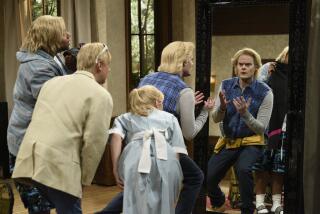A âTunaâ With Lots of Dressing
We hold this truth to be self-evident: that all residents of Tuna, Texas, are created funny.
Their creators have endowed them with certain unalienable comic signatures. Among them are wigs, voices and the pursuit of the quickest possible changes of costumes and characters.
Thatâs a fancy way of saying that âRed, White and Tuna,â at La Mirada Theatre, is set on the Fourth of July--and that itâs a lot funnier than the Declaration of Independence. In fact, this latest installment of tales from Texasâ third-smallest (fictional) town, by the creators of âGreater Tunaâ and âA Tuna Christmas,â is funnier than just about any other show in Greater L.A.
Protean sketch comics Jaston Williams and Joe Sears play 10 characters each. They wrote the script with director Ed Howard. The fourth vital member of the team is costumer Linda Fisher.
You need not have seen the previous âTunaâ shows to understand or appreciate this one, but veterans of the others will enjoy recognizing many of the characters, and they will relish the chance to see what happens to a few of the narrative strands from the previous shows.
Most important, the suggestion of possible romance between radio commentator Arles Struvie (Williams) and troubled mom Bertha Bumiller (Sears) in âA Tuna Christmasâ has blossomed into an engagement by the beginning of this show. But the couple is soon squabbling. Should the honeymoon destination be his choice--the Rattlesnake Roundup--or hers, the passion play in Eureka Springs, Ark.? Arles isnât interested in seeing some kid from Texas A&M; dressed up as Jesus; he has another kind of passion in mind for the wedding night.
Actually, Bertha, too, is looking forward to marital pleasures--a fact that disgusts her now-grown son Stanley (Williams), best known from previous shows as a reform school habitue. Stanleyâs an artist in New Mexico, and he has the all-black clothes and turquoise jewelry to prove it. He has returned to oversee the installation of some of his dubious-sounding art at the high school reunion.
Stanley is soon shocked to learn that sex is not far from the thoughts of even his matronly Aunt Pearl (Sears). However, Pearlâs priority right now is winning the title of queen of the high school reunion, which coincides with the Fourth of July festivities. So itâs especially uncomfortable for Pearl when she and her opponent Vera Carp (Williams), the affluent Smut Snatcher who refers to all of her maids as âLupe,â must borrow the current Lupeâs car to travel with her rival to the reunion.
Also up for queen is the ratty-looking used-weapons dealer Didi Snavely (Williams), whoâs more interested in whether her missing husband R.R. (Sears) is ever going to return. She has just about decided to move on with her life when R.R. makes a grand entrance.
A number of other characters who were in earlier shows briefly come and go: Arlesâ easygoing radio partner Thurston Wheelis (Sears), Berthaâs now-pregnant daughter Charlene (Williams), unappreciated thespian Joe Bob Lipsey (Sears), animal rights activist Petey Fisk (Williams). Tastee Kreme waitresses Inita Goodwin (Sears) and Helen Bedd (Williams) operate the reunion food booth, where a suspiciously âtangyâ potato salad has been sitting in the July sunshine for several hours.
Two new characters also appear: unreformed hippies Star Birdfeather (Sears) and Amber Windchime (Williams), who are in town for the reunion. Satirical depictions of hippies may not sound like the freshest shtick. But Tuna is far from the cutting edge of social trends, so itâs not totally anachronistic to see hippies here in 2000. Besides, these are as funny as everyone else--just watch Searsâ Star adjust her blond flowing tresses. Williamsâ timing, as Amber delivers the last line of the first act with its one-word reflection on life in Tuna, is perfect.
Searsâ reedy voice belies his ample girth, while Williamsâ gravelly growl emerges from a slender frame. These qualities lead to plenty of risible combinations. But with no disrespect intended to the actors and director, Fisherâs costumes--especially those of the women of Tuna--produce as many laughs as any other single element.
The script is better with one-liners than with conventional notions of structure. We miss seeing the actual announcement of who is named reunion queen. Iâd like a better glimpse of Stanleyâs art.
Yet the show does feature a special visual effect that should not be disclosed in advance. Letâs just say that it adds an element of wild, otherworldly comedy to the mundane surface of life in Tuna. That surface is wittily expressed in Kevin Rupnikâs set, which suggests both the frame of the Alamo and the endless prairie in one piece.
As with the last Tuna show, the satire never completely hides a basic affection for the characters. You wouldnât want to live in Tuna, but itâs a great place to visit.
* âRed, White and Tuna,â La Mirada Theatre, 14900 La Mirada Blvd., La Mirada. Tuesdays-Saturdays, 8 p.m.; Saturdays-Sundays, 2:30 p.m.; Sundays, 7:30 p.m. Ends Feb. 13. $34. (714) 994-6310, (562) 944-9801. Running time: 2 hours, 5 minutes.
More to Read
The biggest entertainment stories
Get our big stories about Hollywood, film, television, music, arts, culture and more right in your inbox as soon as they publish.
You may occasionally receive promotional content from the Los Angeles Times.










